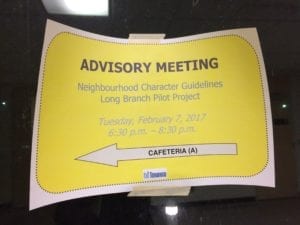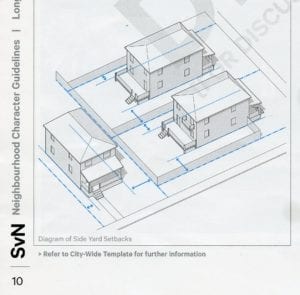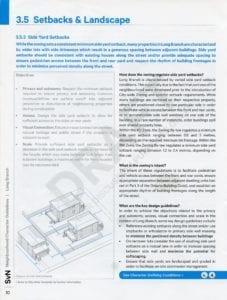Pages 10 & 11 of Feb. 7, 2017 Long Branch Guidelines Draft focuses on 3.5 Setbacks & Landscape
Update:
A more complete and highly informative overview of the contents of the Feb. 7, 2017 Long Branch Urban Design Guidelines Draft Document is available at the website of Ward 6 Councillor Mark Grimes. We owe thanks to Councillor Grimes for the role that he and his office have played in the initiation and development of the Pilot Project.
Click here to access the overview at the Ward 6 Councillor’s website >
[End]

An earlier post shares highlights from the Feb. 7, 2017 meeting of the Long Branch Guidelines Community Advisory Group. Jaan Pill photo
3.5 Setbacks & Landscape
The introduction to page 10 reads:
3.5.3 Side Yard Setbacks
While the zoning sets a consistent minimum sideyard setback, many properties in Long Branch are characterized by wider lots with side driveways which result in a generous spacing between adjacent buildings. Side yard setbacks should be consistent with existing houses along the street and/or provide adequate spacing to ensure pedestrian access between the front and rear yard and respect the rhythm of building frontages in order to minimize perceived density along the street.
Objectives
The text for Objectives for 3.5 Setbacks & Landscape reads:
- Privacy and autonomy: Respect the minimum setback required to ensure privacy and autonomy. Common incompatibilities are surface runoff into adjacent properties or disturbance of neighbouring properties during construction
- Access: Design the side yard setback to allow for sufficient access to the sides or rear yards
- Visual Connection: Ensure a visual connection between natural heritage and public street if the property is adjacent to such
- Scale: Provide sufficient side yard setbacks as a decrease in the side yard setback entails an increase of the facade, which may make buildings look larger than adjacent buildings; a maximum width for front facades may be recommended

Diagram of Side Yard Setback for Objective: 3.5 Setbacks & Landscape. Note below diagram reads: Refer to City-Wide Template for further information. Source: Long Branch Draft Reference Material. Feb. 7, 2017, page 10
*
Click on the images to enlarge them; click again to enlarge them further
*
Page 10 of the Reference Material features the following additional text:
How does the zoning regulate side yard setbacks?
Long Branch is characterized by varied side yard setback conditions. This is partially due to the fact that portions of the neighbourhood were developed prior to the introduction of City-wide Zoning and specific setback requirements.
While many buildings are centred on their respective property, others are positioned closer to one particular side in order to facilitate vehicle access between the front and rear yards, or to accommodate side wall windows on one side of the building. In a rare number of instances, older buildings spill over shared property lines.Within the RD Zone, the Zoning By-law regulates a minimum side yard setback ranging between 0.6 and 3 metres, depending on the required minimum lot frontage. Within the RM Zone, the Zoning By-law regulates a minimum side yard setback ranging between 1.2 to 2.4 metres, depending on the use.
What is the zoning’s intent?
The intent of these regulations is to facilitate pedestrian and vehicle access between the front and rear yards, ensure appropriate separation between adjacent dwelling units (set out in Part 3 of the Ontario Building Code), and establish an appropriate rhythm of building frontages along the length of the street.
What are the key design guidelines?
In order to achieve the objectives related to the privacy and autonomy, access, visual connection and scale in the context of Long Branch, some key design guidelines include:
- Reference existing setbacks along the street and/or use stepbacks or articulation in primary side wall massing to minimize the perceived density between buildings.
- On narrower lots consider the use of abutting side yard setbacks as a mutual lane in order to increase spacing between side wall and maximize the potential for softscaping.
- Ensure that side yards are landscaped and graded in order to facilitate on-site stormwater management.
A note at the end of the text reads:
See Character Defining Conditions > c., d.
*
Related Posts
Previous posts, in a series about the Guidelines Pilot Project, include:

The first half of the Feb. 7, 2017 meeting of the Guidelines Advisory Group was devoted to presentations about the contents of the Guidelines Draft. Jaan Pill photo
Urban Design Guidelines Pilot Project has been launched in Long Branch (June 28, 2016)
How to read the streets of Long Branch: Urban Design Guidelines Pilot Project is now underway (July 12, 2016)
Long Branch Guidelines Pilot Project: David Godley shares his version of an Illustrated Analysis Grid (Aug. 11, 2016)
Advisory Group for Long Branch Urban Design Guidelines had a productive meeting on Feb. 7, 2017 (Feb. 7, 2017)
Pages 2 & 3 of Guidelines Draft: Exmoor Drive above TTC Loop is now included in Long Branch Guidelines project (Feb. 8, 2017)
Pages 4 & 5 of Feb. 7, 2017 Long Branch Guidelines Draft focuses on 3.2 Height & Massing
(Feb. 9, 2017)
Pages 6 & 7 of Feb. 7, 2017 Long Branch Guidelines Draft focuses on 3.3 Building Elements (Feb. 10, 2017)
Pages 8 & 9 of Feb. 7, 2017 Long Branch Guidelines Draft focuses on 3.4 Driveways & Garages (Feb. 14, 2017)
I’ve shared a detail series of questions, that members of the Advisory Group were asked to comment upon at the Feb. 7, 2017 meeting, which is described at one of the above-noted posts.
Focus Questions for Long Branch Urban Design Guidelines Community Advisory Group
A short version of the list of questions reads:
1. Do you have any suggested refinements to the Long Branch Character Framework Plan?
2. What do you like about the draft guidelines? How could they be improved?
3. Are there any additional guidelines we should consider?
4. Do you have any suggestions for the approach / format for the public meeting?


![Figure 79: [Text unavailable as of Feb. 7, 2017]](http://preservedstories.com/wp-content/uploads/2017/02/3.5-detail-1-p-11003-300x294.jpg)
![Fig. 80. [Text unavailable as of Feb. 7, 2017]](http://preservedstories.com/wp-content/uploads/2017/02/3.5-detail-2-p-11004-300x300.jpg)
![Figure 81. [Text unavailable as of Feb. 7, 2017]](http://preservedstories.com/wp-content/uploads/2017/02/3.5-detail-3-p-11005-300x189.jpg)
Leave a Reply
Want to join the discussion?Feel free to contribute!